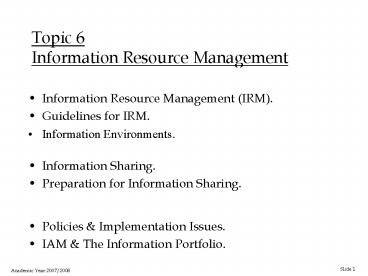IAM IRM - PowerPoint PPT Presentation
1 / 17
Title:
IAM IRM
Description:
The emphasis is on integral, efficient and economic management of all the ... Sources and types of information to be catered for. Cont'd. Source: Ward & Peppard (2002) ... – PowerPoint PPT presentation
Number of Views:149
Avg rating:3.0/5.0
Title: IAM IRM
1
Topic 6Information Resource Management
- Information Resource Management (IRM).
- Guidelines for IRM.
- Information Environments.
- Information Sharing.
- Preparation for Information Sharing.
- Policies Implementation Issues.
- IAM The Information Portfolio.
2
Information Resource Management (IRM)
IRM is a holistic approach to the management of
the information resources (assets) of an
organisation. Ward Peppard (2002)
- The emphasis is on integral, efficient and
economic management of all the organisations
information. - It means getting the right information to the
right people at the right time.
Note the term Information Asset Management (IAM)
is increasingly common.
Contd
Source Ward Peppard (2002)
3
Information Resource Management (IRM) Contd
- IRM seeks to build up the information resources
(assets) of an organisation at an acceptable
cost, so that they can be employed to deliver
value to the business. - The IRM concept emphasises a strategic view.
Source Ward Peppard (2002)
4
Guidelines for IRM
- Aspects to consider include criteria for
- Determining the cost versus value of providing
information. - Defining standards of information quality,
accuracy, security and timeliness. - Responsibilities and allocation of ownership.
- Satisfying the individuals need for information.
- Sources and types of information to be catered
for.
Contd
Source Ward Peppard (2002)
5
Guidelines for IRM (Contd)
- Aspects to consider include criteria for
(Contd) - What levels and forms of information should be
provided. - How to determine the scope and methods for key
practices. - Principles relating to making the user community
aware of the scope of IRM, and how to optimise
their use of information. - What constitutes an issue that needs to be
resolved, and the means to do so.
Source Ward Peppard (2002)
6
Information Environments
None of us, collectively or singly, is able to
embrace the universe of information around us.
Instead, we search for comprehensible nuggets of
information in corners of the universe that we
are familiar or comfortable with. In effect,
individuals and organisations map out information
environments of their own making. Despres
Chauvel (2000)
Contd
7
Information Environments (Contd)
- From these environments we appropriate (and
subsequently, perhaps, recombine) the most
valuable nuggets of information. - A variety of media are then available to bundle
/ store this information - must be interpreted to provide a coherent meaning
Contd
Source Despres Chauvel (2000)
8
Information Environments (Contd)
Paper Records
Private Records
Personal Databases
Management Information
External Information
Operational Databases
Official Information Records
Unrecorded
Total Information Environment
Contd
Source Ward Peppard (2002)
9
Information Environments (Contd)
Paper Records
Private Records
Personal Databases
Management Information
External Information
Operational Databases
Official Information Records
Unrecorded
Total Information Environment
Automated Environment
Contd
Source Ward Peppard (2002)
10
Information Environments (Contd)
Paper Records
Private Records
Personal Databases
Management Information
External Information
Operational Databases
Official Information Records
Unrecorded
Possible Scope of Managed Environment
Total Information Environment
Automated Environment
Source Ward Peppard (2002)
11
Information Environments (Contd)
- The target scope of the managed environment is
determined by - business needs and priorities.
- Typically it will contain
- information that must be accurate and reliable.
- information used by a broad section of the
business (and often by external partners). - everyone uses a common definition.
- there may be more than one copy, but it is
managed to ensure consistency and integrity.
Source Ward Peppard (2002)
12
Information Sharing
- A usual requirement when introducing IAM.
- Can encompass interfaces with
- one business unit
- several units, divisions or companies within the
same group - external organisations
- In its simplest form information sharing means
only one copy of a piece of information is held
and all authorised users have access to it.
Contd
Source Ward Peppard (2002)
13
Information Sharing (Contd)
- Complexity increases if multiple vendors,
hardware platforms, operating systems, DBMSs and
network protocols are involved. - Complexity and risk increase if the situation is
volatile and frequent changes to both the
environment and the applications portfolio are
expected. - A solution that incorporates consistent copies of
information, enables information sharing and
information management must be found.
This is a very complex technical problem, outside
the scope of this module.
Source Ward Peppard (2002)
14
Preparation for Information Sharing
- Determine the business needs and benefits -
defined in the business IS strategy. - Define the technical requirements and the
practicalities of the provision. - Describe the information to be shared and the
community of authorised users. - Decide how to overcome barriers brought about by
differences in management style and local values
and cultures within an organisation. - Resolve issues of interdepartmental or company
rivalry.
Source Ward Peppard (2002)
15
Policies Implementation Issues
- Physical Factors.
- Tools.
- Organisational Responsibility for IRM.
- Authority Responsibility for Information.
- Information Security.
- Implementation Issues.
Source Ward Peppard (2002)
16
IRM The Information Portfolio
Aim is to bring information into the managed
environment according to needs, priorities the
risks of not managing it. Ward Peppard (2002)
- Focusing on strategic information.
- Evaluate key operational information and
determine how best to exploit its potential at
acceptable cost and risk. - Watch high potential information which may become
strategic. - Possibly ignore low potential support information.
Source Ward Peppard (2002)
17
References
- The following text was used in the preparation of
this material. - Despres, C. Chauvel, D. (2000) How to Map
Knowledge Management, in Mastering Information
Management, pp. 170-176, (eds. D. A. Marchand, T.
H. Davenport T. Dickson), Financial Times,
Prentice Hall. - Ward, J. Peppard, J. (2002) Strategic Planning
for Information Systems, 3rd ed., Wiley.































